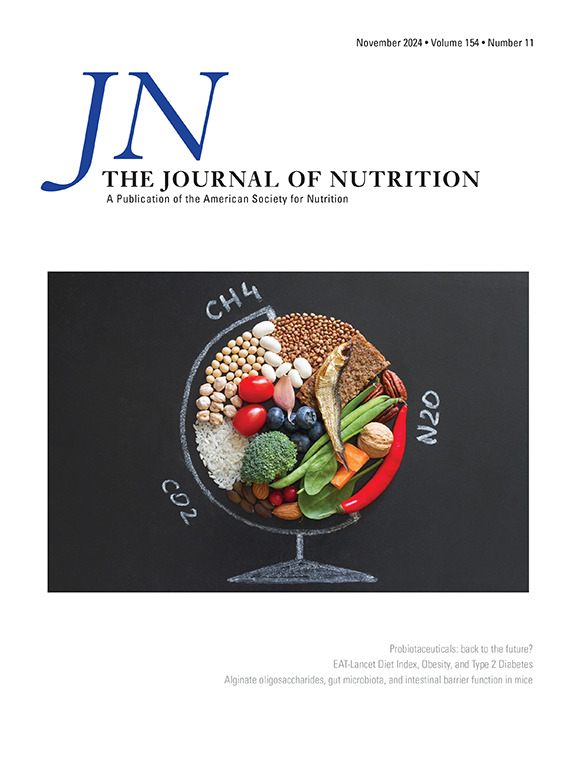幼儿微量营养素膳食生物标志物的模式和决定因素及其与膳食摄入量的关系。
IF 3.7
3区 医学
Q2 NUTRITION & DIETETICS
引用次数: 0
摘要
背景:循环膳食生物标志物并非摄入量的直接替代物,因为生物标志物不仅反映食物和补充剂的摄入量,还反映营养素的吸收、代谢和组织分布。因此,除了营养素摄入量外,其他一些上游因素也会影响膳食生物标志物的浓度,包括人口、病史和遗传因素:本研究旨在探讨 6 个月至 4 岁儿童体内维生素 A、C、D 和 E 循环水平的膳食和非膳食决定因素:对1490名参加青少年糖尿病环境决定因素(TEDDY)研究的儿童的2887份样本中的血浆视黄醇、β-胡萝卜素、抗坏血酸、25(OH)D、α-生育酚和γ-生育酚进行了测定。膳食摄入量通过 3 天的食物记录进行评估。使用带随机截距的多变量线性回归模型检验了遗传和环境因素与生物标志物浓度的关系:结果:除视黄醇外,所有生物标志物都与相同营养素的摄入量呈正相关。近期胃肠道感染与β-胡萝卜素、抗坏血酸和α-生育酚之间呈反向关系,而近期呼吸道感染与血浆视黄醇呈反向关系。研究发现了生物标志物状态的几个遗传决定因素,验证了之前报道的研究结果。对于某些遗传和环境暴露,我们发现了与同种营养素摄入发生统计学交互作用的证据,这表明摄入量与生物标志物浓度之间的关联取决于这些其他暴露的水平或状态。例如,在最近受到呼吸道感染的儿童中,β-胡萝卜素摄入量与浓度之间的关联较弱:我们的研究结果表明,包括儿童感染在内的非膳食暴露会改变微量营养素的代谢。通过对微量营养素决定因素的总结,我们可以更好地了解相关的潜在混杂因素以及膳食-结果关系的中介因素,这将有助于改进今后探讨膳食在儿童慢性病病因学中作用的分析设计。本文章由计算机程序翻译,如有差异,请以英文原文为准。
Patterns and Determinants of Micronutrient Dietary Biomarkers and Their Associations with Dietary Intakes in Young Children
Background
Circulating dietary biomarkers are not direct proxies for intake, as the biomarkers reflect not only food and supplement consumption but also nutrient absorption, metabolism, and tissue distribution. Therefore, along with nutrient intake, several other upstream factors can impact dietary biomarker concentrations, including demographic, medical history, and genetic factors.
Objectives
The aim of this study was to explore the dietary and nondietary determinants of circulating levels of vitamins A, C, D, and E among children aged 6 mo–4 y.
Methods
Plasma retinol, β-carotene, ascorbic acid, 25(OH)D, α-tocopherol, and γ-tocopherol were measured in 2887 samples from 1490 children enrolled in The Environmental Determinants of Diabetes in the Young study. Dietary intake was assessed with 3-d food records. Associations of genetic and environmental factors with biomarker concentrations were examined using multivariable linear regression models with random intercepts.
Results
All biomarkers except retinol were positively associated with intake of the same nutrient. Inverse associations were identified between recent gastrointestinal infection and β-carotene, ascorbic acid, and α-tocopherol, whereas recent respiratory infection was associated inversely with plasma retinol. Several genetic determinants of biomarker status were identified, validating previously reported findings. For some genetic and environmental exposures, we found evidence of statistical interaction with same-nutrient intake, indicating that the association between intake and biomarker concentration is dependent on the level or status of these other exposures. For example, the association between β-carotene intake and concentration is weaker among children with a recent respiratory infection.
Conclusions
Our findings suggest that nondietary exposures including childhood infections can alter micronutrient metabolism. This summary of micronutrient determinants will facilitate improved design of future analyses exploring the role of diet in childhood chronic disease etiology through a better understanding of relevant potential confounders and mediators of the diet–outcome relationships.
求助全文
通过发布文献求助,成功后即可免费获取论文全文。
去求助
来源期刊

Journal of Nutrition
医学-营养学
CiteScore
7.60
自引率
4.80%
发文量
260
审稿时长
39 days
期刊介绍:
The Journal of Nutrition (JN/J Nutr) publishes peer-reviewed original research papers covering all aspects of experimental nutrition in humans and other animal species; special articles such as reviews and biographies of prominent nutrition scientists; and issues, opinions, and commentaries on controversial issues in nutrition. Supplements are frequently published to provide extended discussion of topics of special interest.
 求助内容:
求助内容: 应助结果提醒方式:
应助结果提醒方式:


